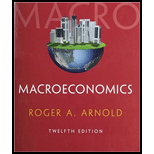
Describe the simple majority decision rule with a numerical example.
Explanation of Solution
Suppose the government decides to make a cost benefit analysis in the economy, it takes 6 persons including supporters and the people who oppose the project. Also calculate the cost and benefit from them as shown in the table below:
Table 1
| Voters | Benefits | Taxes | Votes |
| A | 50 | 30 | Yes |
| B | 40 | 30 | Yes |
| C | 35 | 30 | Yes |
| D | 31 | 30 | Yes |
| E | 2 | 30 | No |
| f | 1 | 30 | No |
According to the table, the analysis is taken between 6 persons. The total cost of the project is given as $180 and the total benefit from it is given as $159. Here, the total cost from the product is greater than the total benefit. As per the rule, the government will not take the project on reality. However, in this case, the majority of them in the side of supporters of the project than the antagonist. Then here the majority decision rule can take place, the project is passed, even though its cost is high.
Cost benefit analysis: Cost benefit analysis is a process to analyze the cost of the project and the benefit from it. Also, this process helps to decide the project being undertaken or rejected.
Simple majority decision rule: The majority rule is a decision rule, if majority support the project than the opposed, the project will be passed, and even its cost is greater than the benefit from it.
Want to see more full solutions like this?
Chapter 20 Solutions
Macroeconomics (Book Only)
- not use ai pleasearrow_forwardUse the following table to work Problems 5 to 9. Minnie's Mineral Springs, a single-price monopoly, faces the market demand schedule: Price Quantity demanded (dollars per bottle) 10 8 (bottles per hour) 0 1 6 2 4 3 2 4 0 5 5. a. Calculate Minnie's total revenue schedule. b. Calculate its marginal revenue schedule. 6. a. Draw a graph of the market demand curve and Minnie's marginal revenue curve. b. Why is Minnie's marginal revenue less than the price? 7. a. At what price is Minnie's total revenue maxi- mized? b. Over what range of prices is the demand for water from Minnie's Mineral Springs elastic? 8. Why will Minnie not produce a quantity at which the market demand for water is inelastic?arrow_forwardDon't give AI generated solution otherwise I will give you downward Give correct answer with explanationarrow_forward
- The Firm's Output Decision (Study Plan 12.2) Use the following table to work Problems 4 to 6. Pat's Pizza Kitchen is a price taker. Its costs are Output (pizzas per hour) Total cost (dollars per hour) 0 10 1 21 2 30 3 41 4 54 5 69 4. Calculate Pat's profit-maximizing output and economic profit if the market price is (i) $14 a pizza. (ii) $12 a pizza. (iii) $10 a pizza. 5. What is Pat's shutdown point and what is Pat's economic profit if it shuts down temporarily? 6. Derive Pat's supply curve.arrow_forwardUse the following table to work Problems 27 and 28. ProPainters hires students at $250 a week to paint houses. It leases equipment at $500 a week. The table sets out its total product schedule. Labor (students) 1 Output (houses painted per week) 2 23 5 3 9 4 12 5 14 6 15 27. If ProPainters paints 12 houses a week, calculate its total cost, average total cost, and marginal cost. At what output is average total cost a minimum? 28. Explain why the gap between ProPainters' total cost and total variable cost is the same no matter how many houses are painted.arrow_forwardUse the following table to work Problems 17 to 20. The table shows the production function of Jackie's Canoe Rides. Labor Output (rides per day) (workers per day) Plant 1 Plant 2 Plant 3 Plant 4 10 20 40 55 65 20 40 60 75 85 30 65 75 90 100 40 75 85 100 110 Canoes 10 20 30 40 Jackie's pays $100 a day for each canoe it rents and $50 a day for each canoe operator it hires. 19. a. On Jackie's LRAC curve, what is the average cost of producing 40, 75, and 85 rides a week? b. What is Jackie's minimum efficient scale?arrow_forward




 Managerial Economics: A Problem Solving ApproachEconomicsISBN:9781337106665Author:Luke M. Froeb, Brian T. McCann, Michael R. Ward, Mike ShorPublisher:Cengage Learning
Managerial Economics: A Problem Solving ApproachEconomicsISBN:9781337106665Author:Luke M. Froeb, Brian T. McCann, Michael R. Ward, Mike ShorPublisher:Cengage Learning Managerial Economics: Applications, Strategies an...EconomicsISBN:9781305506381Author:James R. McGuigan, R. Charles Moyer, Frederick H.deB. HarrisPublisher:Cengage Learning
Managerial Economics: Applications, Strategies an...EconomicsISBN:9781305506381Author:James R. McGuigan, R. Charles Moyer, Frederick H.deB. HarrisPublisher:Cengage Learning





